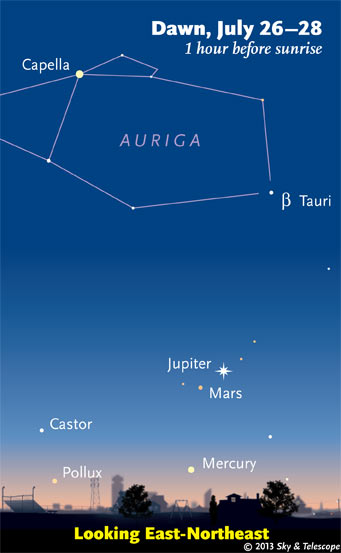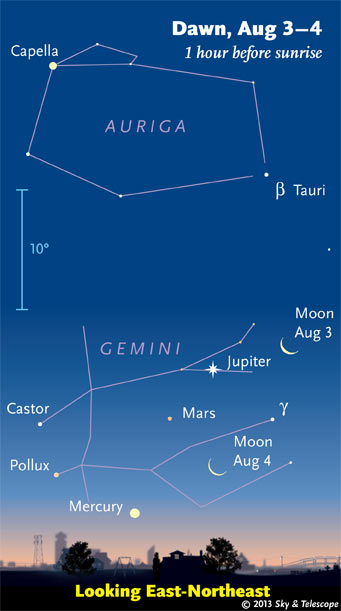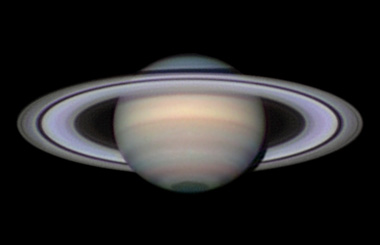
Jupiter is climbing higher above faint Mars low in the dawn. And on what morning can you first pick up Mercury?
Friday, July 26
Saturday, July 27
Sunday, July 28
Monday, July 29
Tuesday, July 30
Wednesday, July 31
Thursday, August 1
Friday, August 2
As summer begins to wane, The Big Dipper hangs diagonally on the wall of the northwestern sky during evening. It's about as high as bright Arcturus, shining left of it in the west.

As dawn begins to brighten on August 3rd and 4th, look for the thin Moon and three planets. This view is drawn for 1 hour before sunrise for a skywatcher at mid-northern latitudes in North America. Binoculars may help for the fainter objects. The blue 10° scale is about the size of your fist held at arm's length.
Saturday, August 3
Want to become a better amateur astronomer? Learn your way around the constellations. They're the key to locating everything fainter and deeper to hunt with binoculars or a telescope.
This is an outdoor nature hobby. For an easy-to-use constellation guide covering the whole evening sky, use the big monthly map in the center of each issue of Sky & Telescope, the essential guide to astronomy. Or download our free Getting Started in Astronomy booklet (which only has bimonthly maps).
Once you get a telescope, to put it to good use you'll need a detailed, large-scale sky atlas (set of charts). The standards are the little Pocket Sky Atlas, which shows stars to magnitude 7.6; the larger and deeper Sky Atlas 2000.0 (stars to magnitude 8.5); and the even larger Uranometria 2000.0 (stars to magnitude 9.75). And read how to use sky charts with a telescope.
You'll also want a good deep-sky guidebook, such as Sue French's Deep-Sky Wonders collection (which includes its own charts), Sky Atlas 2000.0 Companion by Strong and Sinnott, the bigger Night Sky Observer's Guide by Kepple and Sanner, or the beloved if dated Burnham's Celestial Handbook.
Can a computerized telescope replace charts? Not for beginners, I don't think, and not on mounts and tripods that are less than top-quality mechanically (able to point with better than 0.2° repeatability, which means pretty heavy and expensive). As Terence Dickinson and Alan Dyer say in their invaluable Backyard Astronomer's Guide, "A full appreciation of the universe cannot come without developing the skills to find things in the sky and understanding how the sky works. This knowledge comes only by spending time under the stars with star maps in hand."
This Week's Planet Roundup
Mercury, Mars, and Jupiter shine low in the east-northeast during dawn. Jupiter is the highest and brightest (magnitude –1.9). Look for faint Mars (magnitude +1.6) a little to Jupiter's lower left. Look below them, and perhaps a bit left, for Mercury, which brightens from magnitude +1 to 0 this week. Best time: about 60 to 40 minutes before your local sunrise. See the illustrations above. Binoculars may help with the fainter two planets, especially through summer haze.
Venus (magnitude –3.9) shines brightly low in the west in evening twilight. In a telescope Venus is still small (12 arcseconds) and gibbous (83% sunlit).

Double-shadowed Saturn. Saturn is near eastern quadrature during July and August (90° east of the Sun), so this is when its globe casts the widest shadow onto the rings behind as seen from Earth's viewpoint. That's the black band on the rings just off the globe at lower right of center (celestial northeast).
Meanwhile, the rings are now casting a prominent shadow onto the globe. That's the black rim above the rings here (south is up). Both shadows add to Saturn's 3-D appearance in a telescope.
The gray band on the globe just inside the rings is the semitransparent C Ring, the sparse "Crepe Ring," with no shadow currently behind it to confuse its appearance.
Damian Peach took this excellent image on July 19th using the powerful stacked-video method. Don't expect Saturn to look this clear and crisp in any telescope visually!
Saturn (magnitude +0.6, in Virgo) glows in the southwest just after dusk, with Spica 12° to its lower right. Look almost as far to Saturn's left for fainter Alpha Librae. Less than 0.9;° upper right of Saturn this week is dim Kappa Virginis, magnitude 4.3.
Uranus (magnitude 5.8, in Pisces) and Neptune (magnitude 7.8, in Aquarius) are nicely placed in the southern sky before the beginning of dawn. Finder charts for Uranus and Neptune.
All descriptions that relate to your horizon — including the words up, down, right, and left — are written for the world's mid-northern latitudes. Descriptions that also depend on longitude (mainly Moon positions) are for North America. Eastern Daylight Time (EDT) equals Universal Time (also known as UT, UTC, or GMT) minus 4 hours.
Like This Week's Sky at a Glance? Watch our SkyWeek TV short, also playing on PBS.
To be sure to get the current Sky at a Glance, bookmark this URL:
http://SkyandTelescope.com/observing/ataglance?1=1
If pictures fail to load, refresh the page. If they still fail to load, change the 1 at the end of the URL to any other character and try again.
 0
0
Comments
You must be logged in to post a comment.